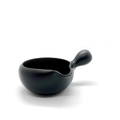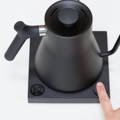Unlocking the Perfect Brew:
The Best Brewing Temperature for Japanese Tea

Brewing tea is like unlocking a treasure - when done correctly, its true flavours come alive!
Temperature of water is possibly the most overlooked consideration for the majority of tea drinkers. Yet, it plays a fundamental part in the enjoyment of tea.
I have been told many times by a number of people 'I don't like green tea because it is too bitter'. The bitterness occurs because the water they are brewing with is beyond the temperature threshold for the style of tea they are consuming.
Truth be told, there’s not much you can do to make a badly produced tea taste good.
But bad brewing can destroy a premium quality tea! Teas are more delicate than you may think.
So what temperature should you be brewing at? See our chart below.
Tea Brewing Temperature Chart
If you can control the temperature you can control the taste.
Water temperature directly effects the rate of extraction in tea.
When you brew too hot, the extraction is like a shooting star.
All of the flavours are released rapidly (over extracted) and in the cup, the taste is unbalanced leaning toward more bitterness and higher astringency and not much else.
Inversely, when you brew too low (under extracted), the extraction is very slow and does not allow the individual flavour compounds of the tea to shine.
You’ll also find that when brewing at higher temperature, the finish of the tea on your palette lingers for longer and is more pronounced.
Whereas a lower temperature steep will have a softer, smoother finish.
What it boils down to (excuse the pun), is that tea is a magical mixture of flavour compounds and the temperature you brew at holds the key to unlocking its perfect balance.
Try exploring a tea’s range of flavour by brewing at different temperatures.
When I test tea I tend to change 1 variable at a time.
For example, in this test I brewed 4 grams / 200ml water of our delicious Benifuuki Wakocha at 100°C and I let it steep for 2 minutes in a clay teapot.
The brewed liquor is dark and rich in colour.
I repeated the process again, but this time I reduced the water temperature down to a low 60°C. I kept the same gram/water ratio and steep time at 2 minutes.
The brewed liquor is much lighter and golden like.
We recommend brewing our Benifuuki Wakocha between 85°C - 90°C. Judging by the colour you can tell at only 60°C, the leaves have much more flavour to release.
How to Reduce Water Temperature for Tea Brewing?
Method 1: Cost effective but dangerous!
Most standard kettles in our kitchens cut off automatically once they reach a boiling temperature of 100°C.
100°C is somewhat off the temperature we want to be at for Japanese green tea.
One way to reduce water temperature of boiling water is to transfer water between 2 mugs several times over.
If you have 2 pitchers (like the ones used to steam milk) then that will be far safer.
Each time you transfer the water from one vessel to another will reduce the temperature by approx 5°C.
DO THIS WITH EXTREME CAUTION as you can easily burn your hands during the transfer.
Method 2: The Traditional Japanese way. (Much safer than method 1)
Use a Japanese water cooler. In Japan, it is called a Yuzamashi (Pictured)
The Yuzamashi is sometimes featured in Japanese tea ceremonies. They are made from earthenware and have a wide opening like a teapot but shallow.
This open design is ideal for faster water cooling. They also feature a side handle for accurate pouring along with a free flowing spout for mess free pours.
You can use a Yazumashi by pouring boiling water from your kettle into the Yuzamashi.
Doing this will quickly and conveniently reduce the temperature to 90°C.
If you want to cool even further - say 80°C you can let the water sit in the Yuzamashi for longer or transfer the water into your tea cup to warm up the tea cup.
From the tea cup, you can then transfer into the teapot and start brewing.
Method 3 - Variable Control Kettle. The modern and most precise method.
If you want to take your tea brewing to a whole new level, then a temperature controlled kettle is the best way to go. It does come at a price though 🙁
There are a few varieties on the market available with a host of features and benefits.
Some have preset temperatures that are programmed into the kettle. Usually they are at 5°C intervals between 80°C - 95°C
The kettle I use at home is the Fellow EKG Temperature control kettle.
What I like most about this kettle is that it has an analogue temperature dial so you can adjust in increments of 1°C within a range of 57°C to 100°C and is shown on a LCD display.
Another great feature of this kettle is the HOLD temperature function. It can hold your desired temperature for up to 1 hour. This is a fantastic feature when you want to re-brew several times in 1 session.
There’s no need to re-boil the water. Super convenient and an amazing feature when I’m trying to dial in my personal temperature preference.
Final Thoughts on Water Temperature and Tea
As you can see, temperature plays an important role in the taste and experience of your cup of tea.
Tea is largely affected by water temperature so it’s important to take the time to understand each type of tea before diving into trying them out.
Keeping a thermometer or temperature checker handy will help you arrive at the correct temperature for each type of tea, allowing the flavours to shine through.
Further, be sure to experiment with different temperatures; a few degrees difference can make all the difference and it could be the key to unlocking your favourite cup of tea.














